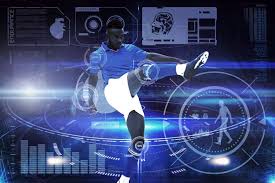
The world of sports is evolving rapidly, with technological advancements and innovative solutions transforming how athletes train, compete, and recover. Technology in sports has come a long way, with breakthroughs that are reshaping athletic performance, fan engagement, and even the business side of sports. From wearable technology to data analytics and artificial intelligence (AI), the future of sports is set to become even more integrated with cutting-edge tools and solutions.
In this article, we’ll explore the ways technology and innovation are changing the landscape of athletics, enhancing performance, improving safety, and shaping the future of sports as we know it.
1. Wearable Technology: Revolutionizing Training and Performance
One of the most significant technological advancements in sports is the rise of wearable devices. These gadgets, such as fitness trackers, smartwatches, and GPS-enabled trackers, are enabling athletes to monitor and improve their performance in real-time.
Key Benefits of Wearable Technology in Sports:
- Performance Monitoring: Devices like heart rate monitors, accelerometers, and smart shoes track metrics such as speed, distance, calorie burn, and heart rate, allowing athletes to fine-tune their training for optimal results.
- Injury Prevention: Wearable technology helps detect patterns in movement, posture, and stress on the body, offering real-time data that can prevent overuse injuries or poor technique.
- Recovery Optimization: Wearables also track recovery metrics, such as sleep quality and muscle fatigue, helping athletes optimize their recovery and reduce the risk of burnout.
Wearable technology is empowering athletes to take control of their fitness, offering invaluable insights that help them push their athletic potential further.
2. Data Analytics: Turning Raw Information into Performance Insights
In the age of big data, sports teams and individual athletes are increasingly relying on data analytics to enhance their performance. The ability to collect, analyze, and apply performance data in real time is a game-changer.
How Data Analytics is Shaping Sports:
- Real-Time Performance Insights: Coaches and athletes now have access to advanced metrics—such as player speed, stamina, and shot accuracy—during games, allowing them to adjust tactics on the fly.
- Player Evaluation and Recruitment: Teams are using data-driven approaches to assess an athlete’s potential and skill set, making recruitment decisions more informed and strategic.
- Predicting Injury Risks: By analyzing an athlete’s movement patterns, fatigue levels, and training intensity, data analytics helps predict potential injuries before they occur, allowing for proactive care and prevention.
The ability to make data-driven decisions has transformed how coaches prepare their teams and how athletes approach training and recovery.
3. Artificial Intelligence and Machine Learning: Enhancing Athletic Performance
Artificial intelligence (AI) and machine learning (ML) are playing an increasingly prominent role in sports. From personalized coaching to strategy optimization, AI is helping athletes enhance their skills and improve performance in ways that were previously unimaginable.
Key Applications of AI in Sports:
- Personalized Training Plans: AI-powered platforms analyze an athlete’s historical performance data and design personalized training programs tailored to their unique strengths, weaknesses, and goals.
- Smart Coaching: AI systems are being used to provide real-time feedback on technique, helping athletes make immediate adjustments to improve their performance.
- Game Strategy Optimization: In team sports, AI is used to analyze opponents’ tactics, player movements, and historical game data, helping coaches devise smarter strategies for upcoming matches.
AI and machine learning offer unprecedented opportunities for athletes and coaches to unlock hidden potential and stay ahead of the competition.
4. Virtual Reality (VR) and Augmented Reality (AR): Transforming Training and Fan Experience
The introduction of virtual reality (VR) and augmented reality (AR) in sports is revolutionizing both the training process and the fan experience. These immersive technologies are enabling athletes to train more effectively and fans to experience sports in new and exciting ways.
How VR and AR Are Enhancing Sports:
- VR Training: Virtual reality allows athletes to simulate real-game scenarios in a controlled environment. This helps athletes develop tactical skills, improve decision-making, and practice without the risk of physical injury.
- AR for Skill Development: Augmented reality is being used to enhance skill-building drills by overlaying real-time data, providing visual cues, and allowing athletes to work on technique with instant feedback.
- Enhanced Fan Engagement: AR is transforming the fan experience by offering interactive and immersive content, such as live statistics overlays or virtual stadium tours. Fans can also experience events from different angles using VR technology.
Both VR and AR are creating new dimensions in sports training and entertainment, making sports more accessible and enjoyable for athletes and fans alike.
5. Biomechanics and Motion Capture Technology: Optimizing Technique
Biomechanics and motion capture technology have brought about a revolution in the way athletes and coaches assess technique. By capturing detailed motion data, athletes can fine-tune their movements for optimal performance.
The Role of Biomechanics in Sports:
- Analyzing Movement Patterns: Motion capture technology allows for the detailed analysis of an athlete’s movements, highlighting areas where they can improve efficiency, power, or range of motion.
- Technique Optimization: By assessing how the body moves during specific actions (such as running, jumping, or swinging), biomechanical data helps coaches design training programs that optimize technique and minimize the risk of injury.
- Performance Enhancement: Fine-tuning biomechanics through technology leads to more effective performance, especially in sports where technique is a crucial component, such as swimming, tennis, and gymnastics.
Biomechanics and motion capture are integral in helping athletes achieve their best performance by improving technique and understanding how the body works under different conditions.
6. E-Sports: The Rise of Digital Athletics
As traditional sports evolve, e-sports have emerged as a dominant force in the world of athletics. Competitive video gaming has grown into a multi-billion-dollar industry, attracting athletes and fans worldwide. Technology has played a key role in this rise, creating new opportunities for digital competition and engagement.
The Future of E-Sports:
- Advanced Gaming Technology: Improvements in graphics, processing power, and network speed have made e-sports more immersive and competitive than ever.
- Global Competitions: Major gaming tournaments like the League of Legends World Championship and Dota 2 tournaments draw millions of viewers globally, turning digital athletes into celebrities.
- Sponsorship and Commercialization: E-sports teams are attracting major sponsorships and investments, mimicking the business model of traditional sports leagues.
As technology continues to advance, the future of e-sports looks incredibly bright, offering a new avenue for athletic achievement and fan engagement.
7. The Role of Technology in Sports Safety
Ensuring the safety of athletes is a primary concern for teams, leagues, and sports organizations. Technological innovations are helping to reduce the risk of injuries and ensure that athletes can perform at their best without compromising their health.
Key Technologies Enhancing Athlete Safety:
- Smart Equipment: Helmets, pads, and other protective gear equipped with sensors help monitor impact and provide real-time data on the force of collisions to prevent concussions and other injuries.
- Wearable Sensors for Injury Detection: Sensors embedded in clothing or equipment can track an athlete’s body temperature, heart rate, and stress levels, alerting medical staff to potential health risks before they become serious.
- Concussion Detection Tools: Advanced tools are now available to help assess the likelihood of concussions, enabling quick intervention and preventing long-term health issues.
Technology is improving safety in sports, helping athletes perform at their peak while minimizing the risks associated with physical competition.
Conclusion: The Future of Sports is Here
The future of sports is undeniably intertwined with technology and innovation. With advancements in wearable technology, data analytics, AI, VR, biomechanics, and e-sports, the world of athletics is set to become even more dynamic, efficient, and accessible. Athletes will continue to unlock new levels of performance, fans will enjoy more immersive experiences, and safety standards will rise, ensuring a brighter future for all involved in the world of sports.
As technology and innovation continue to shape the landscape of athletics, we can expect even more groundbreaking changes that will redefine what it means to be an athlete and a fan in the years to come.
SEO Considerations:
- Primary Keywords: Future of Sports, Technology in Sports, Sports Innovation, Wearable Technology in Sports, Data Analytics in Sports, AI in Sports, VR in Sports, Biomechanics in Sports, Sports Safety, E-Sports, Motion Capture in Sports
- Secondary Keywords: Athletic Performance, Sports Performance Technology, AI Training Tools, Sports Technology Trends, Sports Fan Engagement, Sports Injury Prevention, Virtual Reality Sports Training, Sports Technology Innovations, Wearable Fitness Devices
- Meta Description: Discover how the future of sports is shaped by technology and innovation. Learn how wearable tech, AI, VR, and biomechanics are revolutionizing training, performance, and fan experience.
- URL Slug: future-of-sports-technology-innovation-shaping-athletics
